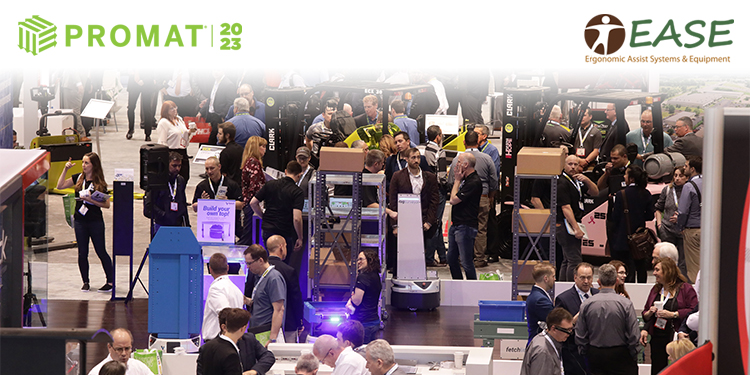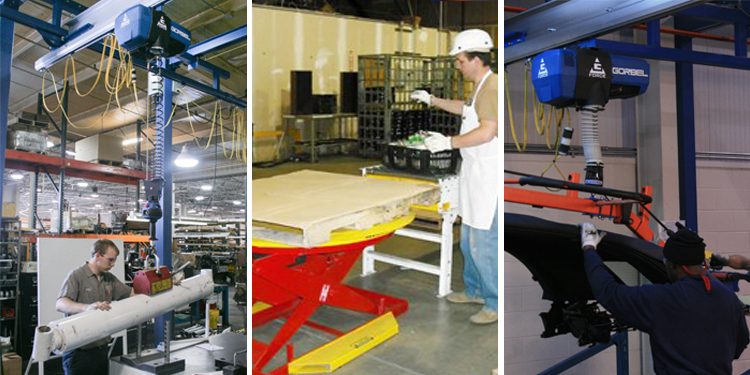EASE Council Presents Panel Of Ergonomists To Discuss Workplace Safety At ProMat 2023

With improper ergonomics representing two of the top 10 non-fatal workplace injuries in the 2022 Liberty Mutual Insurance Workplace Safety Index, it’s more important than ever to implement better workplace safety measures. Together, overexertion when manually handling objects (number 1) and associated awkward postures (number 4) cost employers $16.64 billion annually. It doesn’t have to be this way. Engaging a professional ergonomist to assess safety concerns and recommend practical solutions can improve workplace safety and reduce injuries. Yet many organizations are unaware that such resources exist. Therefore, the members of the Ergonomic Assist Systems & Equipment (EASE) Council of MHI are hosting a panel of three ergonomists to discuss ways to improve workplace safety at ProMat 2023.

Highly Interactive Discussion Planned
The education session, “Maximize Workplace Safety And Minimize Risk: Ask An Ergonomist,” is free to all ProMat attendees. It occurs on Monday, March 20 at 12:45 – 1:30 p.m. Central time in Theater H. All education sessions are in the Knowledge Center, located on the show floor in McCormick Place’s South Hall.

Gary Allread, PhD, CPE, The Ohio State University
Featured panelists include:
- Gary Allread, PhD, Certified Professional Ergonomist (CPE), is Program Director of ergonomics consulting and training services through The Ohio State University’s Spine Research Institute. He has more than 30 years of experience in the field and currently serves as President of the Applied Ergonomics Society.
- Will Heath, CPE and Senior Ergonomist for The Ergonomics Center at North Carolina State University. He has more than 10 years of experience in ergonomics.
- Timothy Pottorff, MSc., CIE, ARM, Global Ergonomics and Safety Consultant at QP3 ErgoSystems. He has spent more than 30 years applying ergonomics research to help companies improve jobs and reduce risks to employees.
This seminar offers attendees the opportunity to hear answers directly from the panelists to key questions about ergonomic best practices that improve workplace safety and reduce risk. It is ideal for both new and experienced safety professionals, as well as persons whose companies lack a dedicated ergonomist.
Why Ergonomics Is Critical To Workplace Safety

Will Heath, CPE, North Carolina State University
In its simplest form, ergonomics is the study of the interaction between a person and their work, said Heath. Yet, when designing supply chain systems, solution planners sometimes overlook the human component.
“Everything from the material packaging, vehicles used, and routes taken are painstakingly considered to deliver part A to factory B as efficiently as possible,” he noted. “But what about the person picking up the box or driving the truck? Have we considered their role in the system? Ergonomics places the human element at the forefront of every design decision. Approaching design this way typically shows improvements in safety, productivity, and quality.”
When properly designed and implemented, ergonomics helps lessen muscle fatigue, increases productivity, and reduces the number and severity of work-related musculoskeletal disorders (MSDs). Work-related MSDs are among the most frequently reported causes of lost or restricted time. Most importantly, work-related MSDs can be prevented.
Additionally, with today’s workforce attraction and retention struggles, tailoring work to the worker has become more critical than ever before.

Timothy Pottorff, Principal, QP3 ErgoSystems
“Ergonomics addresses the impact of work on people, both physically and psychologically,” Allread noted. “This results in tasks that are less fatiguing, work processes that are more efficient, and jobs that are safer for employees to perform. So, ergonomics can help to make jobs not only safer but also more desirable to those doing the work. That improves job satisfaction and employee retention.”
How Ergonomists Help Improve Workplace Safety
“Many organizations may think that as long as they teach their teams to lift correctly there isn’t anything else they can do,” Heath explained. “Yet having an ergonomist on staff is sometimes not an option for many organizations. Outside consultants can help to fill that knowledge gap. If a potential area of concern is identified, we are often able to conduct an analysis and provide recommendations to solve the issue quickly and efficiently.”
Allread agreed. “Board-certified ergonomics consultants often have knowledge of the conditions under which materials handling equipment will improve an operation…or have no benefit at all.”
That expertise can help an organization considering an investment in ergonomic devices or equipment accurately assess the potential impact. “External ergonomists can provide expert input about product features that make it more or less user friendly and, as a result, more or less effective,” he continued. “Ergonomists have the expertise to objectively evaluate proposed equipment and determine its ability to actually improve the safety of a work process.”
The challenge in ergonomics, added Pottorff, is the need to look at factors such as predictability for employees performing physically demanding work.
“There’s a popular television series about jobs that are ‘dirty,’ and in many respects those are the jobs that can be most difficult to improve,” he noted. “Many of these heavy, manual jobs that present increased risks for work-related musculoskeletal disorders are performed by people from disadvantaged socioeconomic groups. That makes it even more important for ergonomists to help companies find ways to implement improvements, even if we are unable to address as many risks as we would prefer.”

Key Ergonomic Takeaways for Attendees
Participants in the EASE Council education session can expect to gather a variety of insights from all three panelists.
Allread anticipates a discussion of different techniques that can maximize the benefits of material handling equipment. He stressed the importance of not only considering the physical demands of a job, but also the surrounding environment, and the workers themselves.
“It’s important to consider employees’ physical capabilities, limitations, and work perceptions when focusing on creating a work system that improves efficiency, safety, and employee job satisfaction,” he said.
Pottorff hopes that participants will leave the session empowered to seek out ergonomic improvements, regardless of budget limitations. “It’s important to be creative and do the best you can with your available resources,” he advised. “Then, create a bucket list of future needs that you address when you can.”
Session attendees will also build their knowledge about ergonomics and workplace safety, continued Heath.
“One thing that I hope to bring to the table is practical experience from real world ergonomic solutions that have been implemented and work already. I also want to make sure that we talk about ergonomics holistically. Ergonomics is not just one person going out and doing an analysis,” he concluded. “It is about every level of an organization working towards a common goal of a safe and efficient workplace.”

EASE Council Members Exhibit Ergonomic Workplace Safety Solutions
Both before and after the education session, ProMat 2023 attendees can explore a variety of products that enhance worker ergonomics and improve workplace safety. Several EASE Council members will have exhibits in the South Hall of McCormick Place. They include:
| EASE Council Member | Booth Number |
| Blickle Wheels & Casters USA | S1838 |
| Cherry’s Industrial Equipment Corp. | S872 |
| Colson Group | S3239 |
| Daifuku Wynright | S3808 |
| Demag | S2423 |
| Gorbel Inc. | S1531 |
| Hamilton Caster & Mfg. Co. | S1816 |
| New Age Industrial Corporation, Inc. | S4312 |
| Schmalz Inc. | S659 |
| Southworth International Group, Inc. | S3331 |
| TAWI USA Inc. | S1259 |
| UNEX Manufacturing, Inc. | S3527 |
Although EASE Council members listed below do not have exhibits at ProMat, their representatives will be at the show. Connect with them through MHI’s exhibit in Booth N6500 or by visiting mhi.org/ease.
- BOSTONtec, Inc.
- Dalmec, Inc.
- Darcor Casters
- Kinetic Technologies LLC
Can’t wait for ProMat to gather fresh ideas about maximizing workplace safety and minimizing risk by incorporating ergonomic material handling solutions? The members of the Ergonomic Assist Systems & Equipment (EASE) Council of MHI are always available to consult, answer questions, and make recommendations about safe equipment use.



